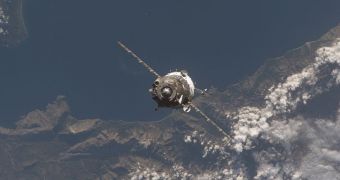Although one month has passed since the return of the Soyuz TMA-11 capsule, carrying on board the crew of the International Space Station's Expedition 16, NASA is just starting to contest the capabilities of the Russian spacecrafts. As you probably already know, the Soyuz TMA-11 returned to Earth on April 19, after a 'ballistic re-entry' which landed it some 475 kilometers away from the designated spot. It was the second time in a row when the Soyuz capsules engage in the ballistic re-entry mode during a descent, risking putting the lives of the crew in danger.
Previously, the Soyuz TMA-10 spacecraft returning from the ISS on October 21, 2007 followed the same backup mode and landed more than 340 kilometers off target. This particular backup mode is applied only when critical systems fail during the re-entry into Earth's atmosphere.
The steep re-entry of the backup mode subjected the crew to unusually high vibrations, which were especially felt by South Korean astronaut Yi So-Yeon, "the first Korean astronaut into space", who had to receive hospital care after having complained of back pain. According to the Russian engineers, the Soyuz TMA-11 capsule entered the atmosphere in an incorrect position, hatch first, damaging the antenna and the hatch of the spacecraft in the process.
The Soyuz capsules are used both to return astronauts from the ISS and as escape spacecrafts in case the ISS suffers some kind of critical failure and can no longer sustain life support. The next mission to the ISS, STS-124, is scheduled to launch on May 31 on board the space shuttle Discovery and should include Gregory Chamitoff as part of the crew.
Chamitoff should replace Garrett Reisman, part of the crew of Expedition 16 and 17. However he may be eliminated from the STS 124 crew to leave room for the return of Reisman with Discovery. If not, Chamitoff would have to return back to Earth at the end of the Expedition 17 mission, on board a Soyuz capsule.
Alternatively, Charmitoff could fly to the ISS and return to Earth along with Reisman on board Discovery.
NASA officials say that the problem that triggered the backup mode on board the TMA-10 and TMA-11 capsules has not been identified yet and is either a manufacturing flaw or a design error that has been overlooked so far. "The bottom line is that if something in our discussion with the Russians indicates that there are issues on the international space station, then we would have to look at adjusting our operations", says Allard Beutel, new director at NASA's Kennedy Space Center.
The Joint Program Flight Readiness Review on the Discovery space shuttle meeting scheduled for May 19 is said to involve an additional heath and status report on the Soyuz capsules docked on the ISS. The latest Soyuz capsule to fly to the ISS, the TMA-12 spacecraft now docked at the ISS, has flown into space Expedition 17 commander Sergei Volkov, flight engineer Oleg Kononenko and spaceflight participant So-yeon Yi.
Currently, the Soyuz capsules are the only means of transportation to the ISS besides the US space shuttle, which will come out of service in 2010. Between 2010 and 2015 NASA will rely only on the Russian spacecrafts for missions to the ISS.

 14 DAY TRIAL //
14 DAY TRIAL //